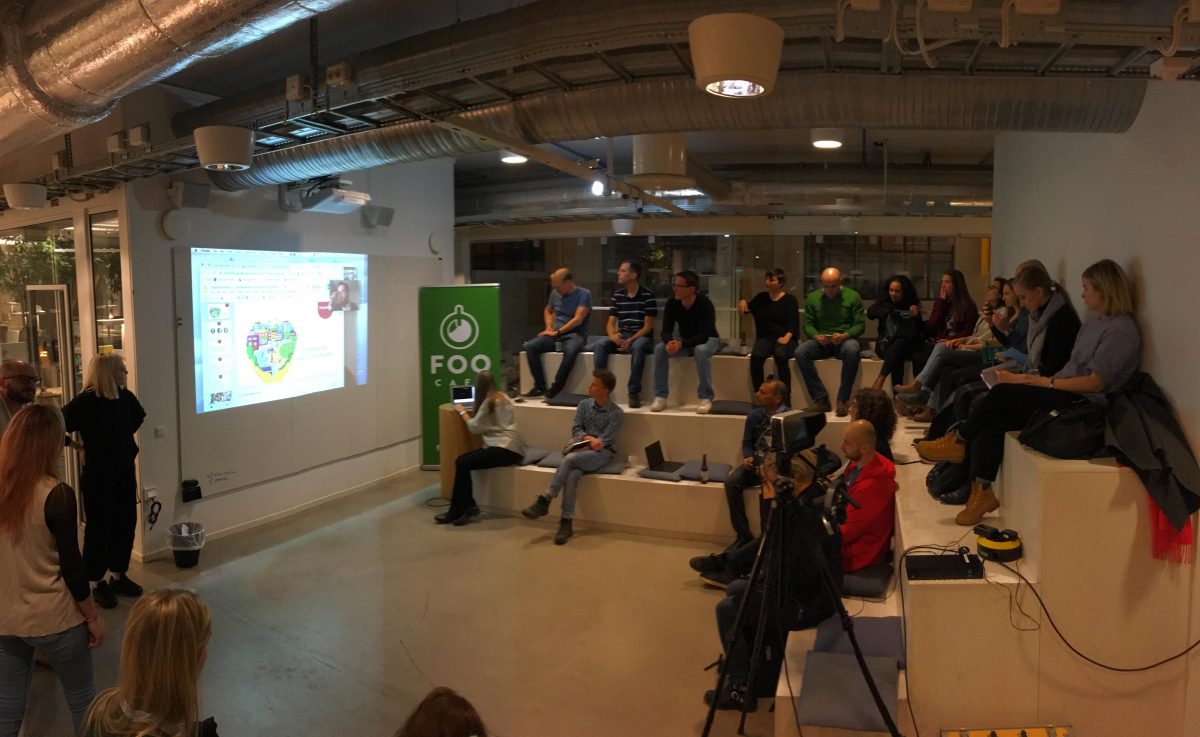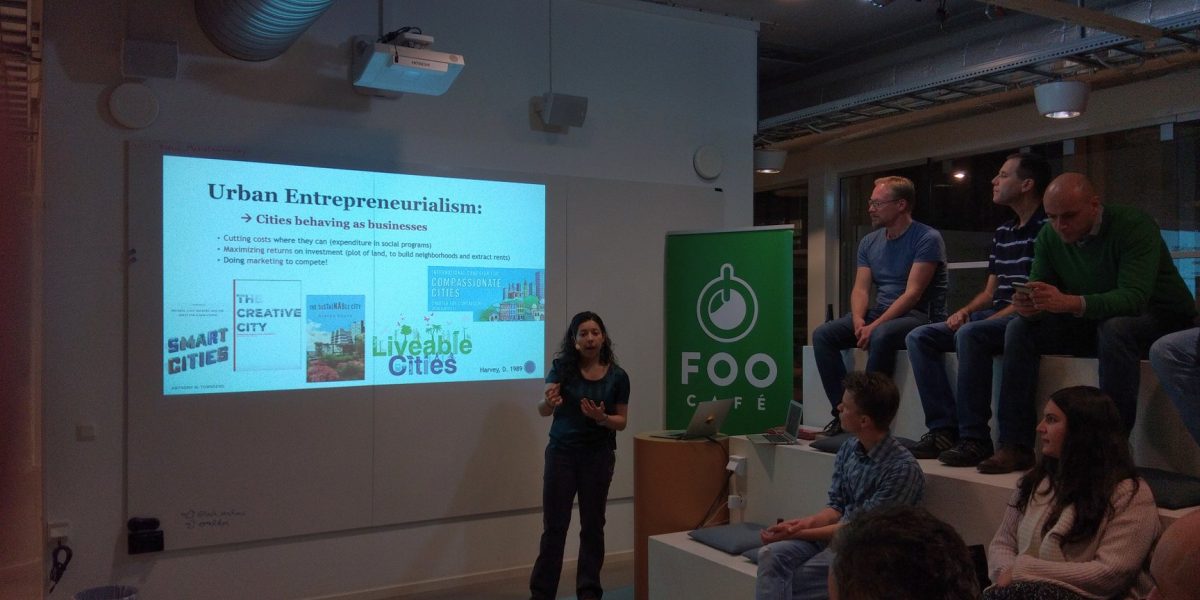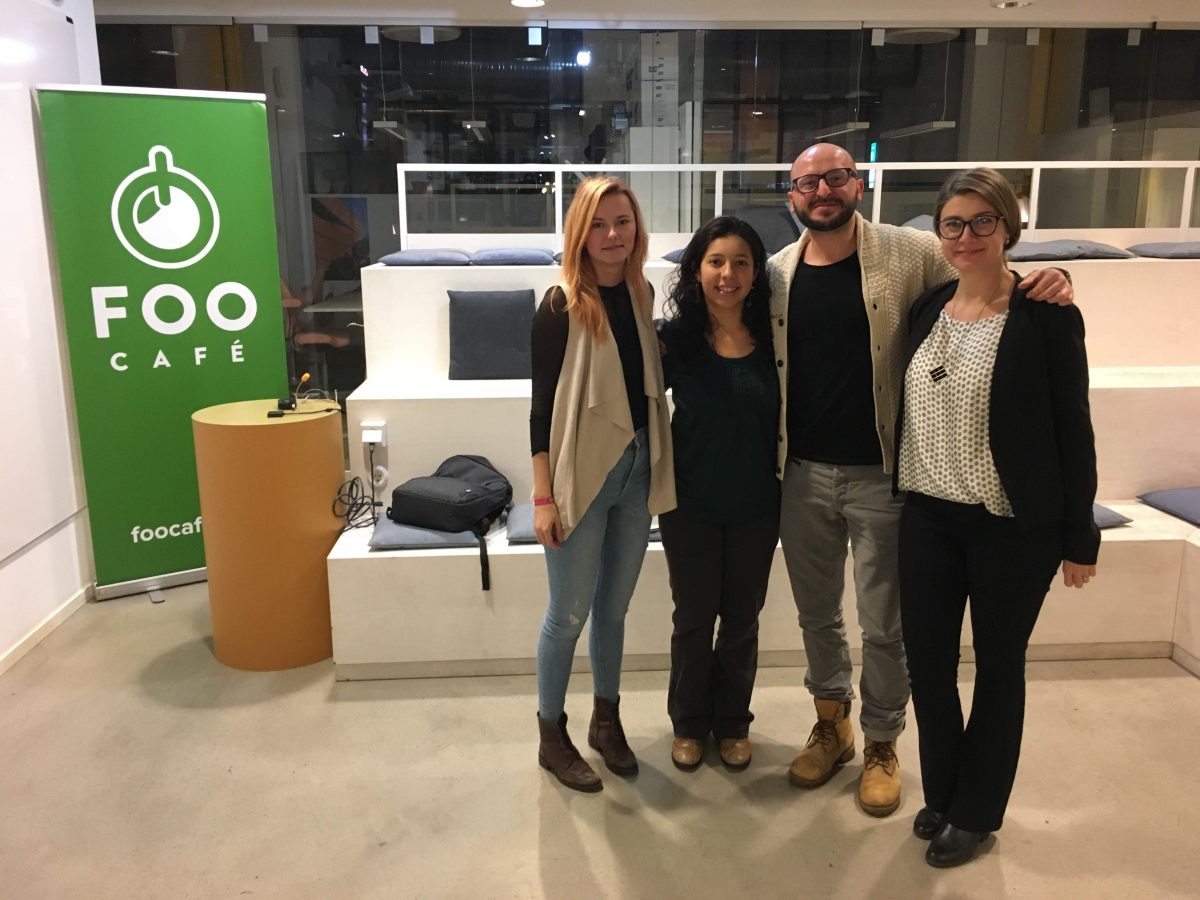by Alejandra Rivera, 4CITIES Cohort 10

One of the amazing rewards of doing fieldwork is the degree of engagement that one can attain when you get submerged in your case study. I went to Malmö like a sponge. I wanted to absorb the environment of the city, the people, the culture, the language, to try to get a feel of what it would be to live there and experience that society. During one of my urban explorations I came across Foo Café, a space for social aims and technology to meet. I wanted to know what this is about, so later that evening I went to one of their free events with food that they offer. How could one resist, right?
I heard a talk by Andrada Tulbure about the “Compassionate Algorithm”, a novel concept to me. She is the leader of a collective called EmpaTech, which is a group of tech industry professionals that are passionate about the social implications of their creations. Her talk revolved around technology forms that are tailored not to efficiency, minimizing cost and improving production, as is often the case, but rather communication, understanding, education. It was a very interesting topic, and little did I know that a couple of months later I would be delivering a presentation on that same stage.
EmpaTech does these kind of presentations on a variety of topics. During a later conversation with Andrada she told me they were interested in doing one event about cities, due to the rampant urban development that cities are experiencing worldwide. They called it “Compassionate Cities”. After learning about my background, she asked if I’d be interested in giving a talk about the subject. It caught me by surprise but I saw it as a great opportunity. I had two presentations to do for classes, a thesis proposal to submit by November, and another presentation to give at the Social Innovation Summit, and it would be even more work to prepare for this one. I quickly said ‘yes’.
Paying back privilege
I think as 4citizens we have a lot to say. This is a unique opportunity, to live and learn in multiple cities around Europe, and the extreme mobility broadens our perspectives. As we grow, so does our privilege, and so we have the huge responsibility to utilize our knowledge and experience to convey our vision. Therefore, any stage, small or large, is an opportunity to make our voices heard. I also saw it as a way to give back to people that helped me with my research in Malmö.
The event was divided in two halves, as we were two speakers. The first, Derek Ruez from the University of Tampere, talked about the “International Chapter for Compassion”. This charter is an agreement between cities to prioritize compassion, and so far a total of 90 cities around the world have signed the agreement and obtained the label of a “Compassionate City”. When I learned about this, I wondered if it was another tactic of urban marketing that we learned about during our Brussels semester. It was exciting and impressive to start witnessing in the real world some of the things that we have learned inside the classroom. Now I was charged with the task to say something about it. So I began…

As an introduction, we need some background information about the contemporary behavior of cities, this phenomenon of ‘urban entrepreneurialism’ that David Harvey talks about. Cities are behaving as businesses: cutting costs where they can (usually expenditure in social programs), maximizing returns on investments (selling plots of land to private developers to build entire neighborhoods and extract rents), and of course cities do a great deal of marketing to compete with each other. We see it happening all around us with various adjectives such as the ‘smart city’, ‘creative city’, ‘livable city’. Is the ‘compassionate city’ just another of these marketing terms? To answer that it is necessary to inquire into the meaning of ‘compassion’ for a city? This I have tried to approach from four different perspectives.
Four perspectives on urban compassion
First, does being compassionate means to promote social inclusion through strategic planning? To respond to urban problems through the lens of compassion, putting the needs of people before economic interests? It is appropriate to recall the concept of urbanism to design ‘cities for people’ from Jan Gehl (who we were introduced to in Copenhagen). Being compassionate could mean to use urban planning as a tool to remediate inequalities and provide those in need with access to resources. As an empirical example, I used the case of Medellín, and data from my thesis to point out how “social urbanism” manifested there through public electric escalators, library parks, and cable cars at the heart of the most impoverished neighborhoods of the city.
A second perspective could be about who plans the city. Given the tradition of the urban planner who dictates how a city is planned and produced, does being a compassionate city mean allowing for ‘organic city making’ and the presence of other actors in the process? To illustrate the difference I took the example of two very different neighborhoods in the same city: Tingbjerg and Christiania in Copenhagen. In Rasmussen’s own words: “From Tingbjerg where everything is regulated and normalized and forced into the right forms in a fully heartless way … to Christiania where everything is free, many would think too free”. The results of everyday social life are striking.
A third possibility of the compassionate city is opting for an urbanism that provides an opportunity for those in need. In a world of inequalities of resources, access, knowledge, and benefits, should we pay more attention to the vulnerable groups of society? I took the example of Shades Tours Vienna from our previous 4CITIES stop. It is a social enterprise that hires homeless people, pays them a salary to work as tour guides and show the city to locals and visitors through their eyes. This creates a double benefit: creating jobs and empowerment to the homeless, and making this issue more visible to the general public.
The fourth and last perspective on this subject of ‘urban compassion’ is the notion of building networks of solidarity. A possible definitions of compassion as building a social fabric of support to ‘the other’, to those who are different to us or come from different backgrounds. This could be evidenced by support to immigrants or in the form of international aid to victims of natural disasters, etc. To illustrate this, there is no need to go too far away, as in Malmö itself many organizations embrace this purpose: MINE, Mitt Liv, Hack Your Future, Yalla Trappan, and the Social Platform. Each one in their own way provides a type of assistance and encourages empowerment of people in vulnerable situations.
Then by trying to figure out what being a ‘compassionate city’ really means through these four perspectives or possibilities, I tried to be critical of the Charter of Compassion that many people have signed. A document is easily signed, but the commitment and the challenge of implementation that it entails is a completely different story. We must recognise that this Charter is grounded in exceptional values and morals, it is an important first step in starting awareness of the need to be compassionate. However, to have a true effect that translates into improvement in quality of life of its citizens, it must be enforced through compassionate tangible actions in cities. Therefore, the behavior and priorities of cities determines their true compassionate character.

I would like to give thanks to Foo Café and EmpaTech who sponsored this event and encouraged me to make this presentation. It served to make me reflect about the notion of being compassionate as a citizen, as a person, and as urbanist. I was happy to share my views on the subject and engage people in an interesting discussion. If I was able to provide a different perspective or create a critical reflection in at least one person in the audience, it is already a monumental and satisfying reward.


